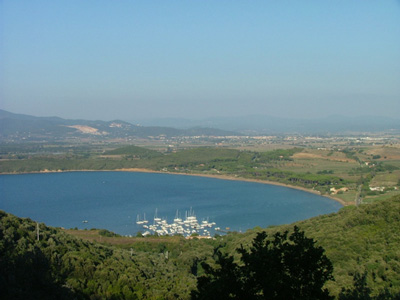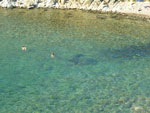Populonia
A special place where the Etruscans built their only city by the sea
Populonia is a very special hamlet in Maremma: well away from the regular Tuscany tourist trails. It is a place - together with the simply stunning Gulf of Baratti that you drive past at the bottom of the hill to reach it - that you must see.

For the views and contemplation of a life here centuries past, let alone the incredible archaeological treasures that both the village and the bay have revealed and which are still being explored today.
It is here that a prosperous Etruscan civilization built their only city by the sea. Visit and you will understand why.
Today, Populonia is a pretty little medieval "borgo" enclosed within a fifteenth century fortress and sitting at the highest point of the Monte Massoncello peninsular. The fortress was built by the Appiani Lord of Piombino to defend the city against marauding Barbary pirates with stones taken from the remains of the adjacent Etruscan Acropolis.

The symbol of the house of Appiani, the dragon, can be seen above the walled gateway - "la porta" - to the village.
 The stunning kite aerial photography images are by kind permission of Opaxir
The stunning kite aerial photography images are by kind permission of Opaxir
The Etruscan city built here was an important one, wealthy and prominent from the smelting of silver and iron ores transported from the many mines the inhabitants owned on the Island of Elba and, likewise, copper ores from their mines in the nearby Metalliferous Hills - Colline Metallifere.
It was the first city in Etruria to coin silver. Its name, Pupluna or Furfluna, is believed to have been taken from the Etruscan god of plant life, happiness, health and growth in all things, Fufluns.
There is also archeological evidence that Populonia was inhabited in neolithic times.
 |
The Gulf of Baratti |
If the ticket office is open, don't miss the opportunity to go up the keep of the medieval fort - it is worth it (even if you have a fear of heights, give it a go), the views from the highest point on the peninsular are so very special. You can see the whole of the Gulf of Baratti (Golfo di Baratti), the Island of Elba (Isola D'Elba), the Etruscan coast (Costa degli Etruschi) laid out in front of you to the north, and the coast of Maremma Grossetana to the south... It is no wonder the Etruscans founded their only city by the sea here: it is pure paradise.
The entrance fee is Euros 2 per person, and free for children.
 |
The Maremma Livornese coast: Costa degli Etruschi |
The video
Shopping
There are a few shops in the village, all designed for tourists. Ethnic clothing, jewellery, and objects for the home etc, a boutique, preserves and pasta, gold & silver jewellery.

Plus one gallery and a privately owned museum exhibiting Etruscan and Roman artifacts from local excavations and discoveries from the Tyrrhenian sea-bed.

Refreshments and parking

A treat to round off the trip to Populonia, is a relaxing drink in the walled garden of the bar and restaurant "La Taverna di Populonia" (when you enter the village portal, it is on your right - you cannot miss it). The service is good and my experience is that there is no pressure if you want to stay a while... but, as in a lot of places, it can be pricey, especially if you have become accustomed to drinking the wonderful Maremman wine brought directly from the many cantinas. Two - lovely - glasses of white wine (for the adults), an ice cream and packet of crisps (for the babes), will set you back over Euros 12,00.
If it is early evening when you are thinking of leaving, wait a while longer: wonder over to the car park and watch the sun go down over the sea. Something for the soul.
The car park is in private ownership and costs Euro 1 for two hours (although we have stayed many times for longer without ever a problem). There are no other choices, unless you park in the car park for the Buca delle Fate cove half way up the hill - it is a steep one - and walk the rest of the way. The exercise will count as more than one days contribution to keeping you healthy! But be aware that there are no pavements and traffic in the summer is busy in both directions along the narrow road.

If you are visting the archeological park, you could park in the free car park for visitors adjacent to the entrance to the Necropoli down the hill in the Gulf of Baratti and catch the ATM public shuttle bus (operates in the spring and summer) up to the Acropoli and Populonia.
The Archeological Park of Baratti and Populonia
- Il Parco Archeologico di Baratti e Populonia

The park comprises the Necropoli in the Gulf of Baratti and the Acropoli in Populonia, with trails between the two to Etruscan tombs - monumental tumulus, shrine and sarcophagus - sites of metal-working, the ancient walls of Populonia, an ancient paved road, old quarries, burials dug into solid rock, the Benedictine monastery of San Quirico, and the remains of the very first Etruscan settlement at Populonia.
The Necropolis is one of the main necropoles in Italy and made such an impression on this fully grown woman that, with rucksack on my back, I ran full tilt down the wooded hillside to see it close-up. Very special and not to be missed.
 |
Photo of the Le Grotte necropolis by kind permission of Roberto Zanasi |
The panoramic views from the walks are just spectacular. The three year old in our party loved the adventure of the trails and the long sinuous lines of huge black ants that covered them!
 |
The paved Etruscan road and visitor path to the Acropolis temples at Poggio del Telegrafo |
There is a vistors' centre and bookshop (the books are available in English, with wonderful photographs), toilets and refreshment area. The telephone number of the park is Tel. 0565 29002.
A great book to buy when you are there or before if you want to read about the Etruscan civilization, the looting of its gold treasure and archaeological excavation is this one.
| Baratti and Populonia Archaeological Park: A Guide to Discovering the Landscape by Andrea Semplici. ISBN 978-88-95116-10-5 - the revised and extended 2008 version. It is available at the onsite bookstore in various languages and costs Euros 12,00. I've checked and only a previous version - 2002 - is available online via Amazon.co.uk |
There are many other wonderfully illustrated books on sale at either of the visitor centres, and I always end up purchasing at least one more each time I visit! But this one is A5 sized and fits easily into a travel bag or rucksac. It is crammed full of colour photographs and fascinating information. Cannot recommend it more highly.
The Archaeological Park of Baratti and Populonia is one of "The Val di Cornia Parks - Nature and archaeology on the Etruscan Coast". The Val di Cornia Parks operate a "pArcheoCARD" discount card if you purchase a group or family ticket. The pArcheoCARD entitles you to a 50% reduction on the price of entrance tickets to the other Val di Cornia Parks parks, 20% discount on the entrance fees to four other parks and centres, and 10% discount at participating restaurants and shops etc.
The pArcheoCARD is FREE, valid for a month (having said that, no one was interested in dating ours!) and well worth holding onto. The savings on a visit to one of the other sites will cover the cost of lunch out! NOTE, the card does not operate during the peak summer season months of July & August.
The other Val di Cornia Parks are:
• Parco Archeominerario di San Silvestro - a great trip out
• Museo archeologico del Territorio di Populonia
• Museo del Castello e della citta di Piombino
• Rocca di Campiglia
The parks are usually closed on Mondays and in certain periods in the autumn and winter.
For more information about The Val di Cornia Parks" go to www.parchivaldicornia.it. (The site is also available in English.)
The place to stay
Tucked behind the tiny church within the fortess walls. With an uninterupted view from the moment you wake in the morning of the whole of the Maremma Livornese coast - the Costa degli Etruschi - and then the glorious seascape sunset that follows. Are these apartments.

Cook up your own dinner to eat on the roof top or, open your door in the fortress wall and stroll just a few steps to one of the bars and restaurants.

The beaches
 Baratti beach
Baratti beach
Explore some more...


















